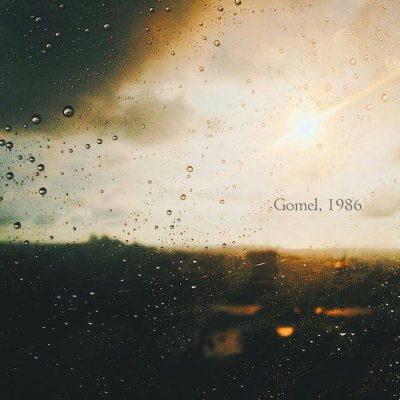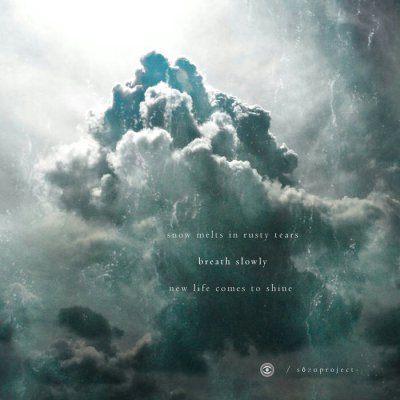
Naviar Records is London Based label who describe themselves as “a community and label that explores the intersection between music and traditional Japanese poetry.” They have been releasing music since March 2014 and these two releases are their latest.
“Gomel, 1986” is an extension of the “Clouded Lands” show (in conjunction with the art collective Food of War) about the 31st anniversary of the Chernobyl disaster and was “a show which aimed to raise awareness on the consequences that such catastrophic events bring in people’s culture and everyday life. For this event, Naviar’s community had to recreate sounds, atmospheres and moods of one of the areas which were mostly affected by the disaster: the region of Gomel, in Belarus”
Each artist had to re-imagine the atmospheres and moods of the time and the recordings were made within a two-week period. The release is available as a limited Cd-r (50 copies) and digital.
“Black Rain” by Dirigent opens the album. Dirigent is San Francisco classically trained composer Chris Christensen who is drawn toward analog electronics and classic tape-studio techniques. The track starts with echoing percussion, water like sounds, electronics, the chiming of clocks, dark ambient drones and recordings of phone calls and media reports in Russian. I haves no idea of what is being said, but there is a certain amount of alarm in the voices, but not overly distraught. The music borders Dark Ambient and Industrial and has an unsettling edge to it. Electronics come in and or in a wave-like fashion possibly inspired by waves of radiation.
“Tjernobyl” by Robert Rizzi. Rizzi is a Danish/American Composer and Sound artist, Master of Electronic Music Composition from DIEM, Aarhus. Robert teaches Electronic Music and Sound art at SDMK Music Conservatoire in Esbjerg, Denmark. He works primarily with field recordings, found scores and improvised instrumental pieces, very often in collaborative site specific installations and compositions with visual artists. Field recordings of rain/ a storm with scattershot sounds are joined by a siren like drone, bass, minimal piano and electronics. The focus is on the field recordings, but the minimal nature of the bass and piano alongside the electronics really brings out the post apocalyptic feel of the music.
“Black Clouds” by Earthborn Visions. Earthborn Visions is a project born out of wide-ranging influences, with a particular affinity for any music that positively influences perception and thinking. They explore juxtapositions of sounds and styles, melodies and noise, planned and random acts, field recordings and electronics, analog and digital. Synth drones slowly unfurl melodically before picking up a darker wind-blown edge and giving a feeling that compliments the title. There is a subtlety to the track, so it’s not too literal in its intentions.
“Cage of Obscured Rain” by IF. IF is Matteo Gazzolo an actor, director, musician, sound designer (founder of Soundethers). He’s been teaching theatrical techniques and text analysis since 1999. He organizes trainings and lectures on acting styles. Matteo lives in Sardinia (Italy) where he plays his stage productions, focusing on the relationship between music, sound technologies (live electronics) and speech. The use of rain sounds return with a more obvious use of weather sourced field recordings. The drones that join are fractured as if they are too also affected by the weather. The drones start to build in intensity and the tone tends to go in a more screechy noise affected way. The track heads into a mix of dark ambient and more melodic fusion with the two opposing styles mixing up in layers and alternating in dominance. The ending of the track is where the field recordings and dark ambience takes hold.
“I Forgot Everything” by In die Ferne. In die Ferne’s first musical experiences date back to the late 80s — playing the guitar in an utterly forgotten noise combo that only recorded 2 tracks. He started making electronic music in the early 2000s. Minimal drones and tones are central to this track. Repetition or loops sees the motif replayed as the drones, while noisy have that classical Eno style to them. The rough / noisy is to the tracks detriment and stands out against the clearer recordings.
“Aftermath” by Jesús Lastra. Lastra aka Jalastram/Flat Stone is a Madrid-based self-taught artist from Maracaibo, Venezuela. He began to experiment with audio editing software in 2007. Then, he started composing ambient music, or more specifically, soundscape, drone and experimental music within the electronic genre. Slow drawn out drones are joined by string drones and a low rumble. The sound is full, but also mournful.With a title like “Aftermath” the artist is clearly trying to convey the post disaster desolation of the area with the heaviness of the drones, the fusion of the elements (strings, piano) and the mood of the times.
With a compilation that comes with a theme or an inspiration there are bound to be cross over of source inspiration eg: field recordings of rain, that said while there are similarities, the artists are able to put their own touches to give a little variation to each piece. The two final tracks probably act as the weaker and stronger pieces on the album. If you like thematic albums this may be for you.

Paolo Mascolini records as sōzuproject. He has released a handful of albums and ep’s. This release on cassette (edition of 59 copies) and digital is his latest. This is the first time he has come across my radar.
The label states that this was “Recorded between December 2016 and February 2017, Breath Slowly describes the composer’s experience while cycling off-road in the mysterious Italian Dolomites in 2016. Divided into two acts, the album depicts an imaginary journey of self-discovery inspired by these desolate and overwhelming mountain landscapes.”
“Ascent” starts off with eerie rumbling, echoing recordings of some sort before layered and occasionally fractured drones arc across the soundscape. Staccato strings cut across before a deep Bassoon like bass drone enters and vibrates out. The music starts to fill out with the strings and the bass thump being joined by noisier sections. The music oscillates with looped electronics joining the fray. As the track continues on the intensity is lifted. If the intention is to convey the intensity of ascending mountains on bicycle and also the desolation of the area, then it is succeeded with the slow build up which dissipates to a more electronica like ending.
“Descent” the drones that start this track have a slightly croaky sound to them as if they are made of field recordings of frogs. A buzzing drone enters the picture and loops with a low-level electronic section barely audible underneath. The electronics start to build up in the mix and their fast paced nature is at odds with the slow intense drones, before they start to challenge the drones which are getting noisier and distorted. There is a subtle wall of noise/ orchestral nature to the drones in the way they sound. The end of the track is like reprise of the beginning with some of the elements featuring again with the electronics still fighting for position.
I have to admit having an expectation to how the tracks would sound in relation to the theme which was completely opposite to the end result. I expected “Ascent” to be intense , which it was, in relation to climbing a mountain by bicycle and ‘Descent” being a more laidback enjoying the scenery feel, which it wasn’t. If you like long form noisy layered drone, then this release might be your cup of tea.
Advertisements Share this:




